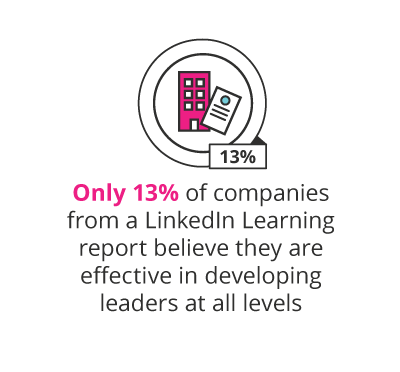Employee Leadership Development from the Ground Up
In the United States, the Social Security Act passed in 1935 declared the age of retirement to be 65. It was also during this time that the average life expectancy was 61 years.1 By the year 2040, this number is expected to grow to 79.8 years, with numbers as high as 85.7 in Japan and 85.8 in Spain.2 For the current young workforce, retirement is evolving and perhaps won’t be the current version of saying goodbye to work at 60+ years in order to travel, play Bingo or spend hours of time on the golf course. The main reason for this expected change? People are living longer.3
If people are living longer, then as a natural consequence, they’ll need to work longer, which requires continual career growth.4 The old rules of retirement were written toward an economy where most of the work being done was manual labour, and reaching the age of 65 was viewed as being liberated from the intensive daily grind.5 However, as disruptive technologies emerge and change the business environment, working professionals are being tasked with having to upskill continually, which presents new opportunities to grow and develop.
As more businesses increasingly identify the need for employees with leadership skills, they’ll soon discover, growing current employees is a lot more cost effective and impactful, than hiring new ones.6 Hiring a new employee instead of training an existing one can cost employers between 50-66% of the existing employee’s annual salary.7
The most successful companies don’t recruit leaders, they grow their own employees from the ground up.8
Although employees with leadership skills are in high demand, companies aren’t confident when it comes to training their existing staff. Only 13% of companies from a LinkedIn Learning report believe they are effective in developing leaders at all levels.9 Research has also shown working professionals are moving from one company to the next due to poor management performance, with employees being four times more likely to leave a company if they rate their manager as having poor performance.10
Younger employees or millennials are citing a lack of opportunities for their reason for leaving their jobs. Millennials are in agreement that the opportunity for leadership development is the number one reason to remain at a company,11 but managers and executives report being concerned when looking at their potential leadership pipeline. In fact, 85% of them feel this way.12

This issue is a training gap, not a skills gap.13 Companies may not be planning effectively when it comes to the development of leadership skills, and this applies to both the entry-level employees and those with more experience. The following five strategies below will guide employers in implementing leadership development from the ground up for all employees:
1. First, identify your company’s leadership skills gap
While it’s important to provide every employee with the opportunity to develop their knowledge and skills, a cost-effective strategy for your company is to identify which leadership positions need to be filled immediately, so you can start providing training as soon as possible. Alexsys Thompson MLC, Author, Executive Coach, and Member of the Forbes Coach Council, says there are a number of assessment tools that allow employers or managers to identify current and possible leadership skills gaps within your company, such as the Leadership Culture Survey by The Leadership Circle group, a litmus test for companies that reveals valuable data on current leadership versus desired leadership.14
Another technique is to send out an anonymous leadership survey to all employees to gain a greater understanding of their career goals, where they feel leadership needs to be improved, and what types of training they are drawn towards.
2. Teach your employees to build relationships
Networking has nothing to do with the number of friends someone has on their social media accounts, but rather how they are connecting with people in their network. Start out small by organising social events so employees can learn how to interact and network internally, before encouraging them to branch outside of the company at media events or conferences. Inform your team networking is an easy way to build relationships and gain access to helpful information and resources.15 If you’re concerned your employees will turn this into a competition of who can get their hands on the most business cards, provide them with these four pieces of advice:16
- Be sincere – this means no schmoozing
- Be a sharer – relationships are all about giving and taking
- Communicate your needs, as well as what you have to offer
- Improve your negotiation skills to help you in knowing when to push hard or back off
- Resolve conflict quickly by searching for mutual agreement and appreciating differing opinions
3. Give your employee a challenge
Unchallenged employees may lose the passion they initially had for the business, which will result in high turnover and teams left in a state of chaos.17 Encourage employees to set monthly or bi-annual goals and then keep communication open with them to hold them accountable. You can also provide employees with more formal challenges and opportunities by paying for external training and short courses, bringing in experts to host workshops, and asking for volunteers to complete tasks outside of their job scope, ensuring opportunities are given to those who put their hand up.18
4. Create an ownership mentality
Employees who have developed an ownership mentality feel empowered in their position to make decisions within their sphere of influence.19 This requires the employer or team lead to delegate effectively, avoid micromanaging, and inject pride into every person in the organisation.20 Another easy way to create ownership mentality is to make every person accountable for their own work. Ensure every employee realises once they are assigned a task, they take complete ownership of that task and if it’s not completed, no one else is going to take over from where they left off.21
Some employers find this is easier to instil in their team members by using incentives, but not everyone responds well to competition. On this point, it’s important to manage any form of negative office politics in your company as soon as it raises its head, otherwise people may start working for their own selfish motives.22
5. Create a learning culture
With the rise of technology comes an increase in the need for skills businesses didn’t know they needed a few years ago. According to World Economic Forum’s “The Future of Jobs Report 2018”, 133 million new job roles are forecasted to emerge by the year 2022.23 Employers are now demanding curiosity and learnability in the work environment, while employees are demanding the opportunity to adapt one’s skill set to remain current and employable. Harvard Business Review gives four recommendations on how to create a learning culture:24

The development of employee leadership is beneficial to your staff and has a positive impact on your bottom line, but with it comes the satisfaction and fulfilling experience of seeing another reach their potential. By ensuring every employee is respected and given a chance to prove their worth, whether they’ve been in the company for six months or 16 years, is a mutually advantageous experience for both parties involved. George Patton, former General of the United States Army once said, “Don’t tell people how to do things, tell them what to do and let them surprise you with their results”.25 Learn to foster an environment that encourages innovation and leadership in every sphere of your business.
- 1 Escamilla, J. (Nd). ‘The social security dilemma’. Retrieved from EDGE. Accessed 8 Mar 2019.
- 2 Foreman, K.J., Marquez, N., Dolgert, A. et al. (Oct, 2018). ‘Forecasting life expectancy, years of life lost, and all-cause and cause-specific mortality for 250 causes of death: reference and alternative scenarios for 2016–40 for 195 countries and territories’. Retrieved from The Lancet.
- 3 (Nov ,2018). ‘Lifespan continues to increase with each generation’. Retrieved from Futurity.
- 4 Bersin, J. (Oct, 2017). ‘The future of work: The people imperative’. Retrieved from Deloitte.
- 5 Koulopoulos, T. (Feb, 2019). ‘It’s time to say it: retirement is dead. this is what will take its place’. Retrieved from Inc.
- 6 Cairnes, R. (Jun, 2018). ‘Here’s why you’re better off retraining employees than hiring new staff’. Retrieved from Business Insider.
- 7 (Nd). ‘Profiling’. Retrieved from Arlandria. Accessed 8 Mar 2019.
- 8 (Nd). ‘Developing employees into leaders interactive guide + workbook’. Retrieved from Linkedin Learning. Accessed 8 Mar 2019.
- 9 (Nd). ‘Developing employees into leaders interactive guide + workbook’. Retrieved from Linkedin Learning. Accessed 8 Mar 2019.
- 10 (2018). ‘Employee retention report’. Retrieved from Tinypulse.
- 11 (2018). ‘The rise of the social enterprise 2018 Deloitte global human capital trends’. Retrieved from Deloitte Insights.
- 12 (Nd). ‘Developing employees into leaders interactive guide + workbook’. Retrieved from Linkedin Learning. Accessed 8 Mar 2019.
- 13 (Nd). ‘Developing employees into leaders interactive guide + workbook’. Retrieved from Linkedin Learning. Accessed 8 Mar 2019.
- 14 (Jun, 2018). ‘Here’s how to identify critical leadership gaps in your organization’. Retrieved from Forbes Coaches Council.
- 15 (Aug, 2017). ‘The top 6 rules of leadership networking’. Retrieved from Center for Creative Leadership.
- 16 (Aug, 2017). ‘The top 6 rules of leadership networking’. Retrieved from Center for Creative Leadership.
- 17 Gregory, A. (Feb, 2019). ‘5 ways to keep employees motivated and challenged’. Retrieved from The Balance Small Business.
- 18 Gregory, A. (Feb, 2019). ‘5 ways to keep employees motivated and challenged’. Retrieved from The Balance Small Business.
- 19 (Nd). ‘Ownership mindset’. Retrieved from Business Agility Institute. Accessed 8 Mar 2019.
- 20 (Apr, 2017). ‘5 ways to build a culture of ownership’. Retrieved from Forbes.
- 21 Reddy, C. (Nd). ‘How to create an ownership mentality in your team?’ Retrieved from wisestep. Accessed 8 Mar 2019.
- 22 Reddy, C. (Nd). ‘How to create an ownership mentality in your team?’ Retrieved from wisestep. Accessed 8 Mar 2019.
- 23 (2018). ‘The future of jobs report 2018’. Retrieved from World Economic Forum.
- 24 Chamorro-Premuzic, T. & Bersin, J. (Jul, 2018). ‘4 ways to create a learning culture on your team’. Retrieved from Harvard Business Review.
- 25 (Jun, 2017). ‘12 inspiring leadership development quotes’. Retrieved from Nexa Learning.
